This article describes the types of product attributes or data types that SKU IQ can sync between integrations.
Overview
SKU IQ can be used for more than just keeping your inventory quantities up to date. We can facilitate making edits to your products between platforms as well. For instance, if you'd like to change the way a product title is written on both your Point of Sale and your eCommerce website, we can automate that change with product attribute syncing. There are a lot of different attributes (AKA product data types or fields) that can be synced between your Point of Sale and eCommerce website. Check out our integrations page to see what attribute syncing options are available for your specfic platform combination.
What is an Attribute?
Product attributes (AKA data type or fields) are properties that describes a product. They include details that are tangible (like size and color) and/or intangible (like the product price). These bits of information helps you and your shoppers find and choose which products are right for them.
What's the Difference Between an Attribute and Quantity?
The quantity is the physical number of items you have available for sale. The attributes describe the products you have available for sale. With SKU IQ, we will always sync your products' quantities as long as the products are linked together. Product attributes on the other hand are voluntarily selected by you to facilitate editing these data types in the future, should something like the size, price, or title need to be changed on both platforms simultaneously. If you are pushing a product, don't worry, the product attributes that can be synced between your platforms will be sent over without issue!
Is Attribute Syncing Bidirectional?
At this time, we can only sync product attributes one way, meaning that you will need to choose a Source of Truth for your attributes. The Source of Truth is where you will be making most of your edits for product attributes (either your eCommerce platform or your Point of Sale web dashboard).
You can certainly pick a different source for each attribute though! If you plan on making most of your price edits on your point of sale and most of your edits of sizes, colors, etc. on your website, we can certainly facilitate that. Just make sure that the attribute you would like to sync edits of is available for your integrations. Check the integration pages for more information.
What Attributes Can SKU IQ Sync?
🚨 NOTE: Not every product attribute listed below is available for every integration. Make sure to check the integration pages to see what attributes can be synced between your platforms.
Title, Name, or Short Description
This is the given name of the product that you would like to have displayed in your register as well as on your website. In the example, you will see that the title has the name of the shoe as well as the color.
Many merchants prefer to have different names on their register versus
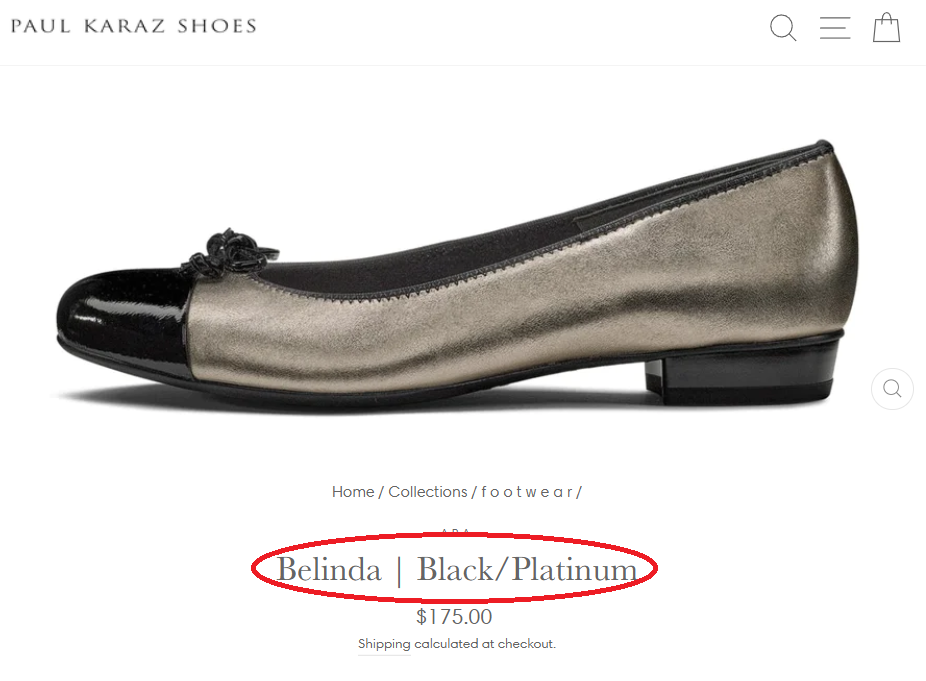
on their website, so not everyone will use this type of syncing. However, if you made a spelling mistake on your website and the item was pushed to your register, instead of having to change it on both platforms, having the title sync from one platform to the other can help facilitate this.
Most platforms will refer to the product name as "Title". Other platforms will refer to the title as the "Name" of the product, or the "Short Description".
Description, Alternate Name, or Long Description
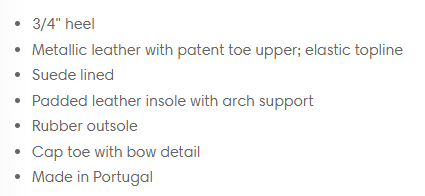
This field is where you put the description of the product. This can include information like where the product was made, what it is made out of, etc.
On your website, you may use HTML codes to make the description look more appealing to your shoppers. These HTML tags do not usually translate well back to the register. This is what the description might look like on your register if you have description syncing turned on from eCommerce website to your Point of Sale.
<ul>
<li>3/4" heel</li>
<li>Metallic leather with patent toe upper; elastic topline</li>
<li>Suede lined</li>
<li>Padded leather insole with arch support</li>
<li>Rubber outside</li>
<li>Cap toe with bow detail</li>
<li>Made in Portugal</li>
</ul>
The best recommendation is to make sure that description syncing only goes from your eCommerce to your Point of Sale, if you have it turned on at all. This is to prevent deleting your description on your website. The description field deleting on the website is generally due to syncing a blank description from your Point of Sale.
Most platforms will refer to the description as "Description", but some platforms will refer to it as "Alternate Name" or "Long Description".
Price
This field communicates the price you would like to sell your item for. This is not the sales price field. We, unfortunately, do not have the ability to sync the sales price attribute at this time. If you are going to put something on sale and have price syncing turned on, make sure to adjust the price in the price field. 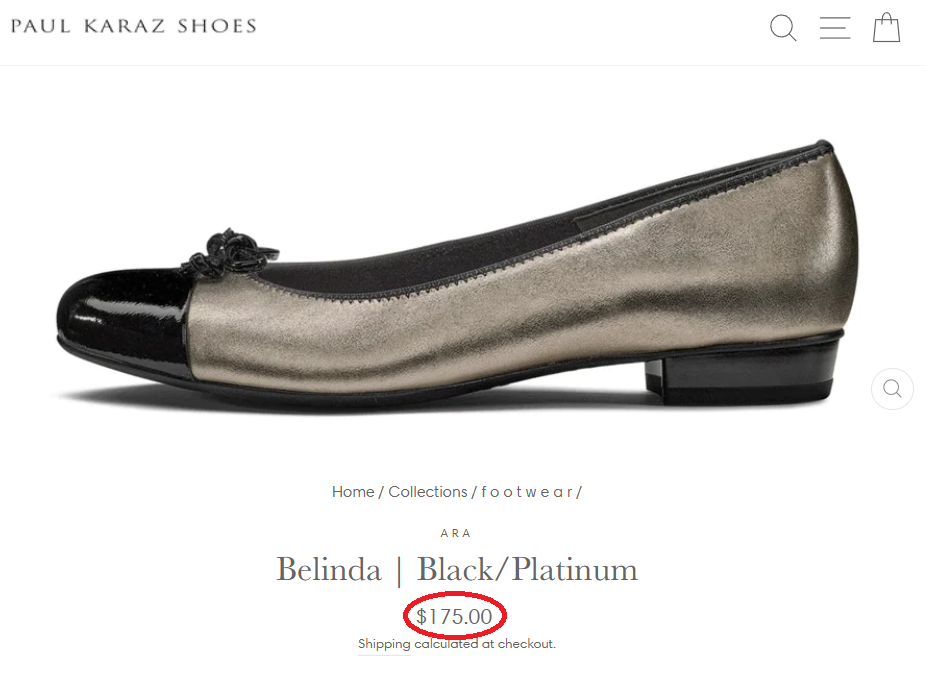
🌟 Price is one of the more popular attributes to be synced between platforms!
Unit Cost or Cost
This field is the cost of the product that you, as the merchant, have spent to purchase it. This field generally will not translate between platforms and is instead pulled in to SKU IQ only. This field is pulled in to SKU IQ to help facilitate calculating the profit in your Sell Through tab. For more information, contact support.
Brand or Vendor
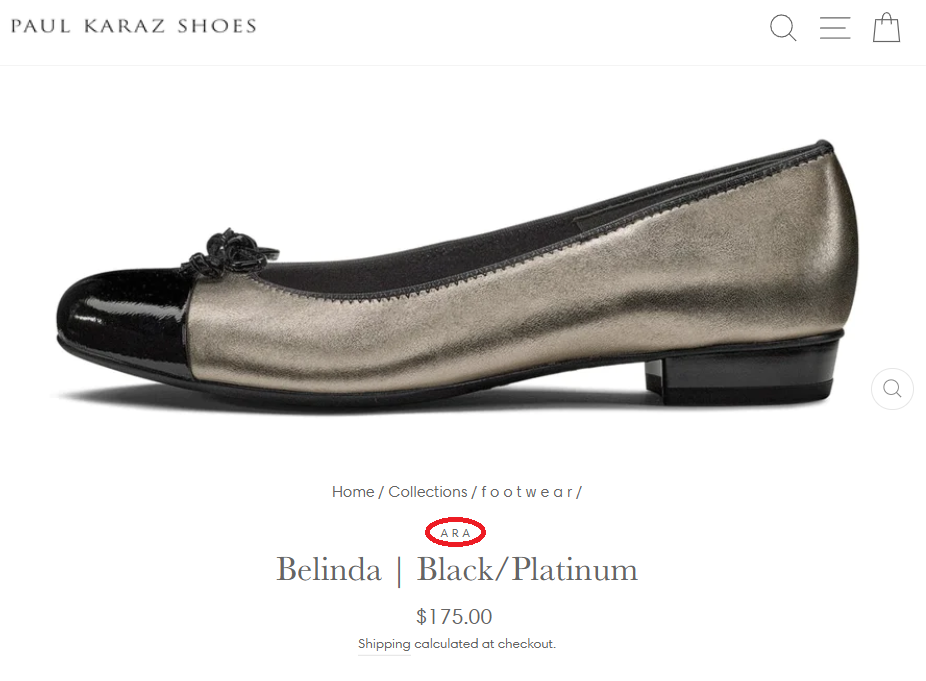
This field indicates who the manufacturer, original seller, or branding label is. In the example, ARA is the brand of the shoe.
This field is not available for syncing on all platforms. Check the integrations pages to see if your platforms will sync this field.
Some platforms will refer to this field as "Brand" while others will refer to it as "Vendor".
Color
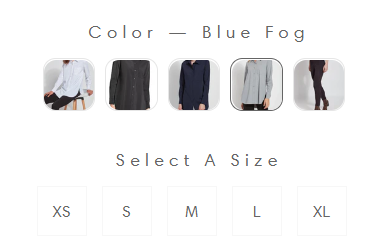
This field indicates what color an item is. This, along with Size, are used to differentiate many apparel items from each other. This attribute is often used to create variants within a specific parent product.
Not every platform will sync this field. Make sure to check your integrations to see if this is a field that can be synced.
Merchants may need to adjust the color depending on if a manufacturer has changed what the color description of their product is. Color syncing allows for you to only have to change the field on one side (either Point of Sale or eCommerce) instead of having to edit it on both platforms.
Size

Size is another attribute that allows you to differentiate products from each other. Most apparel products have different sizes, but you can also use this field for cosmetics, sports equipment, and many other types of products. This is the most common attribute used to create variants.
Not every platform will sync this field. Make sure to check your integrations to see if this is a field that can be synced.
You may need to adjust the size depending on if the manufacturer has changed how they delineate the sizes (e.g. changing from small, medium, large to 1, 2, 3).
SKU
This field is for the SKU, or Stock Keeping Unit, number. This is a unique identifier that merchants often self-generate or use a number generated by the vendor of a product. Some platforms will generate this number for you as well. This number is different from the barcode or UPC number - though some merchants choose to duplicate the UPC number in this field as well.
Some merchants will use SKUs to generate barcodes to use with scan guns for their registers.
🚨 SKU IQ does not have the ability to link the SKU field to the UPC/Barcode field. However, for Lightspeed users, we do offer the ability to sync to a few different fields as the SKU. Please contact support to see what we can do for you.
UPC or Barcode

This field is for the UPC, or Universal Product Code, number. This is a number that is pre-defined
for products made by major manufacturers. This is the barcode number that appears on the product label on the product's packaging. These codes are not always unique and may be used for multiple colors of a particular item. SKU numbers are often used in this instance to indicate the difference in color or size.
Tags
This field is for generating tags that customers can use to search for products on your website. They are also referred to as Keywords. They can include color, brand, size, material type, and many other phrases.
Images
This field is the actual picture of your item! Some platforms will not accept images. Make sure to check your platforms to make sure that images will sync. For the majority of platforms, we can only upload images during the initial push - that means any images edited after the fact will need to be uploaded on both platforms.
| Platform |
File Size (Recommended) |
Resolution (Recommended) |
Supported File Types |
| BigCommerce | 1MB or less | 1028px x 1028px | .GIF, .PNG, .JPEG/.JPG |
| Clover | N/A | N/A | N/A |
| Lightspeed Retail | 8MB or less | 650px x 650px | .GIF, .PNG, .JPEG/.JPG |
| Shopify | 20MB or less | 2048px x 2048px | .JPG/.JPEG, .PNG, .HEIC, .WEBP, .GIF, .TIFF |
| Square | 1MB or less | 1000px x 1000px | .JPEG/.JPG, .PNG, .GIF |
| Wix | 8MB or less | 1200px x 630px | .JPEG/.JPG, .PNG, .GIF, .JPE, .JFIF, .BMP, .HEIC, .HEIF, .TIFF, .TIF, .WEBP, .JPEG 2000, and .RAW |
| WooCommerce | 1MB or less | 1000px x 1000px | .JPEG/.JPG, .PNG, .GIF, .ICO |
| Lightspeed Retail X-Series | 8MB or less | 2000px x 2000px | .JPEG/.JPG, .PNG, .GIF, .TIFF |
